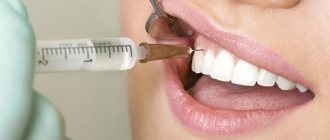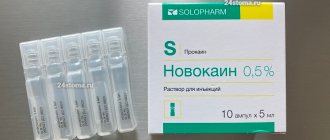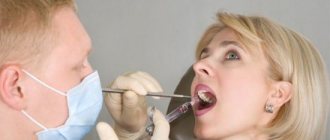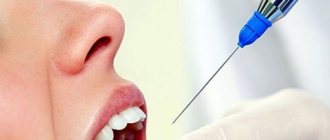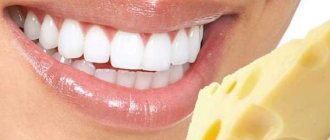From this article you will learn:
- reviews on Ultracain, release forms,
- pros and cons of the drug,
- How much does Ultracaine anesthesia cost?
The article was written by a dental surgeon with more than 19 years of experience.
The anesthetic Ultracaine is a drug in the form of an injection solution that has a very high analgesic effect when administered locally into tissues. The main active component of ultracaine is the substance “articaine hydrochloride” (Articaine), which makes it possible to classify this drug as an anesthetic of the articaine series.
Ultracaine is most often used in dentistry, which is explained by its high efficiency. There are several forms of release of this drug, which differ from each other in the concentration of the vasoconstrictor component that is also included in the composition. The latter is “epinephrine”. This component is added to articaine to locally reduce blood supply in the anesthesia zone, which will reduce the leaching of the anesthetic from the tissues (while increasing the duration and depth of anesthesia).
Anesthetic Ultracaine and carpule syringe –
For dentistry, the anesthetic is not produced in the form of ordinary injection ampoules, but in the form of special cartridges called carpules. Such a carpule is inserted inside a special carpule syringe, which has a piston in the form of a handle, and a special double-edged carpule needle is inserted from the side of the syringe nose. When pressing on the syringe piston, the latter presses on the movable rubber liner inside the carpule, which leads to an increase in pressure inside the carpule and the release of the anesthetic solution through the needle.
Ultracaine release forms –
- ultracaine DS forte (epinephrine concentration 1:100,000),
- ultracaine DS (epinephrine concentration 1:200,000),
- ultracaine D (without epinephrine).
The presence of three forms of drugs is explained by the possible side effects of epinephrine, which can increase the patient's blood pressure. For completely healthy people who do not have cardiovascular or other diseases, Ultracain DS Forte is used. For moderately high blood pressure, Ultracaine DS with a reduced concentration of epinephrine can be used. However, the instructions for use for Ultracain indicate that any of the listed forms can be used from the age of 4 years. We will tell you more about the indications for use of each form below.
How anesthesia is performed in dentistry: video
Ultracaine: price of anesthesia
The cost of 1 carpule of Ultracaine is from 90 rubles (this is the price at which dental clinics purchase it). But in a dental clinic using Ultracain, the price for anesthesia will be approximately 400 to 500 rubles. Unfortunately, you won’t be able to buy a carpule of anesthetic at a pharmacy and bring it with you. This is strictly prohibited by law, because... In this case, the dentist cannot guarantee that the anesthetic is not counterfeit or that it was stored correctly. As a result, the dentist will in any case be to blame for the complications and will be held responsible for it.
How to improve the quality of pain relief?
A patient who is indicated for anesthesia without adrenaline in dentistry can make sure that the effect of the painkiller lasts longer and is of better quality. To do this, he only needs to follow a few general recommendations:
- Before visiting a doctor, if there is strong anxiety and fear of treatment, it is better to take a sedative, preferably based on herbs (for example, about 30 drops of valerian root tincture).
- The day before visiting the dentist, you should not drink alcohol, since alcohol in the blood weakens the effect of the anesthetic.
- If you are taking any medications or have any allergic reactions, you should inform your dentist at the treatment planning stage.
- It is better not to visit a doctor if you feel unwell or during menstruation.
Forms of release of the anesthetic Ultracaine -
Ultracaine: the composition, regardless of the release form, 1 carpool of anesthetic contains the anesthetic articaine 40 mg, and the volume of anesthetic solution in the carpul will be 1.7 ml. As for the content of epinephrine, as we said above, each of the three forms will have its own concentration of this vasoconstrictor component (vasoconstrictor). It should also be noted that ultracaine anesthetic contains the preservative sodium disulfite, which is designed to stabilize epinephrine in the drug. Moreover, since Ultracain D is produced without epinephrine, it will not contain preservatives.
Ultracaine DS forte (epinephrine 1:100.000) –
An excellent anesthetic for achieving a pronounced and long-lasting analgesic effect during surgical interventions in the oral cavity, for depulping teeth, etc. However, this form cannot be used for high blood pressure, severe cardiovascular diseases, thyroid disease and bronchial asthma.
For detailed instructions from the manufacturer, read: → Ultracain DS forte – instructions for use (PDF)
Ultracaine DS (epinephrine 1:200.000) –
The best option for use in patients at risk - pregnant and lactating women, patients with compensated cardiovascular diseases. It is undesirable to use for bronchial asthma. Cannot be used for thyroid diseases.
For detailed instructions from the manufacturer, read: → Ultracain DS – instructions for use (PDF)
Ultracaine D (without epinephrine) –
The optimal choice if there is a high risk of allergic reactions, because... This anesthetic is completely free of any preservatives that are necessary to stabilize anesthetics containing adrenaline. In this regard, it is a good choice also for patients with bronchial asthma. Due to the absence of adrenaline, it can be used for diseases of the thyroid gland. The absence of adrenaline allows its use in patients with severe cardiovascular disorders, but it must be taken into account that the duration of action of the anesthetic without epinephrine/adrenaline will be no more than 20 minutes.
For detailed instructions from the manufacturer, read: → Ultracain D – instructions for use (PDF)
General anesthesia
General anesthesia is a last resort when other methods of pain relief are ineffective. When is general anesthesia used for dental treatment:
- serious surgical interventions (for example, in acute or chronic osteomyelitis, multiple tooth extractions);
- if the patient suffers from dental phobia and there is no other way to cure teeth except to go into medicated sleep;
- if the patient (child or adult) suffers from cerebral palsy, autism, Down syndrome, or other serious mental disorders;
- pronounced gag reflex or extremely profuse drooling;
- allergy to local anesthesia, inability to select suitable drugs.
Contraindications:
- serious heart disease, high blood pressure;
- severe respiratory diseases.
You will first need to take a general blood test and an ECG, as well as consult an anesthesiologist and dentist.
Ultracain: reviews from dentists
As a practicing physician, I try to use this particular anesthetic primarily, although its cost is 1.5-2 times more expensive than similar anesthetics based on articaine.
Thanks to the optimal composition, a minimum of preservatives in the composition (and the complete absence of preservatives in the form of Ultracaine D), this anesthetic can be used in all patients at risk (for cardiovascular, endocrine disorders, allergies, pregnancy and lactation). Ultracaine reviews from dentists are also as favorable as possible because this anesthetic will be a good choice if you have an allergic reaction to amide group anesthetics, for example Novocaine, Lidocaine and others. But in addition to the high safety profile, this anesthetic is also much stronger than its predecessors (see below). In addition, this anesthetic acts in inflamed tissues, but Novocain practically does not anesthetize in the presence of purulent inflammation.
The duration of action and depth of anesthesia will depend on the concentration of epinephrine in the composition of the product, for example, Ultracaine DS forte 1: 100,000 is the most powerful drug in the line. When conducting conduction anesthesia on the lower jaw, the duration of action averages from 2 to 3 hours. With infiltration anesthesia on the lower and upper jaws - a little more than an hour (24stoma.ru).
Ultracaine or lidocaine: which is better?
- Ultracaine is stronger than Novocaine - 5-6 times,
- more effective than lidocaine - 1.5-2 times.
Why is adrenaline needed in anesthesia?
Adrenaline is a vasoconstrictor - a substance that narrows blood vessels. Therefore, on the one hand, its presence in the drug provides a longer-lasting analgesic effect, and on the other hand, it reduces the risk of bleeding during dental procedures (for example, during tooth extraction).
Given this, dentists always warn patients that anesthesia without epinephrine in dentistry has a shorter lasting effect and is not suitable for long procedures. In cases where the patient is indicated for pain relief using non-adrenaline anesthetics, treatment must be carried out very quickly or divided into stages so that the doctor has the opportunity to provide anesthesia before each subsequent stage of manipulation.
If you have a problem similar to that described in this article, be sure to contact our specialists. Don't diagnose yourself!
Why you should call us now:
- We will answer all your questions in 3 minutes
- Free consultation
- The average work experience of doctors is 12 years
- Convenient location of clinics
Single contact phone number: +7
Make an appointment
Ultracaine during pregnancy and breastfeeding
The optimal form of this anesthetic during pregnancy is Ultracaine DS with an epinephrine concentration of 1:200,000. The use of anesthetics without epinephrine (or adrenaline) in pregnant and lactating women is generally not recommended. This is due to the fact that adrenaline, by constricting blood vessels at the injection site, slows down the absorption of the main component (articaine) into the blood, and accordingly this will reduce the peak concentrations of articaine in the blood, and therefore its possible side effects on the fetus.
Ultracaine during breastfeeding - after anesthesia with Ultracaine, the content of articaine in breast milk is possible, but the concentration is so low that it cannot cause any harm. Therefore, there is no need to give up breastfeeding. The epinephrine content in Ultracaine DS is also very small and cannot adversely affect either the mother or the child.
Sources:
1. Dental education of the author of the article, 2. Based on personal experience as a dentist, 3. National Library of Medicine (USA), 4. “Local anesthesia in dentistry” (Baart J.), 5. https://dental.sanofi. de/.
ZAKS
The use of nitrous oxide (or laughing gas) is an ancient (used since 1844) and very effective method of pain relief, which has been adopted by the most modern clinics. Inhaling small amounts of nitrous oxide mixed with oxygen causes mild euphoria and has a relaxing and pain-relieving effect (called sedation). Nitrous oxide sedation is absolutely harmless, acts almost instantly, and recovery from it takes 10–15 minutes without any consequences.
Indications:
- fear and anxiety before treatment;
- young age of patients (most often ZAX is used for children);
- long-term treatment (for example, many teeth are removed at once);
- pronounced gag reflex, profuse salivation.
Contraindications:
- age under 3 years;
- severe intoxication, chronic alcoholism;
- mental disorders, severe neurological diseases;
- sensitivity to individual components of the mixture;
- very strong excitement before upcoming dental procedures, hyperexcitability or hysteria (in children);
- 1st trimester of pregnancy;
- use ZAX with extreme caution in case of high blood pressure, previous concussion and other head injuries;
- Serious respiratory tract infections (asthma, bronchitis) may be a contraindication to sedation.
ZAX does not exclude the use of conventional anesthetics. There is no need to prepare for ZAX in any specific way, but 2 hours before the procedure it is highly advisable to refuse any food (you can drink). On the day of sedation, it is better to take a day off from work and not drive. Children are advised to refrain from active games for 1-2 hours after sedation.
Interaction
The simultaneous use of monoamine oxidase inhibitors and tricyclic antidepressants with Ultracaine D-S can cause a significant vasoconstrictor effect. In addition, the active components of this drug, when entering the human body, inhibit the secretion of insulin by the pancreas, which helps reduce the effect of oral hypoglycemic agents.
It is also not recommended to use Ultracain D-S simultaneously with beta-adrenergic receptor blockers .
The combination of Ultracaine with Heparin, Acetylsalicylic acid and other antithrombotic agents increases the likelihood of bleeding. Accidental puncture of the vessel wall can lead to particularly serious bleeding.
Halothane and a number of other drugs for inhalation use increase the sensitivity of the heart muscle to certain catecholamines that cause arrhythmia .
Children
It should be noted separately the features of local anesthesia in children. The technique of local anesthesia in children must be planned so that 100% pain relief is achieved at all stages of treatment, otherwise it will be impossible to carry out the necessary manipulations.
As mentioned above, children under 5 years of age are given an anesthetic without adrenaline (3% scandonest SVC, or septanest 4% SVC).
Children over 5 years old can use an anesthetic with low concentration adrenaline (1:200,000 - Ultracaine DS). The dose of drugs is selected depending on age. Pain relief is performed in children in 3 stages:
- First, a superficial anesthetic gel is applied
- then a small dose (0.1-0.2 ml) of anesthetic is administered;
- after which, after 60-90 seconds (time sufficient for effective anesthesia of the needle path in the soft tissues), the remaining amount of the planned dose of anesthetic is administered.
We wait 5-10 minutes until complete anesthesia occurs. The child, feeling a complete absence of pain, gains confidence in the doctor and gives the opportunity to carry out the necessary intervention.
Pharmacodynamics and pharmacokinetics
This drug is a local anesthetic , which is actively used in dentistry for conduction and infiltration anesthesia. Its use makes it possible to block the depolarization of the nerve ending membrane, which significantly reduces the perception of irritation and the conduction of nerve impulses. The effect of the drug is quite fast and usually lasts 1-3 minutes. The duration of anesthesia lasts on average 45 minutes.
The low content of epinephrine in this drug indicates that the possible effect on the activity of the cardiovascular system is very insignificant, with virtually no increase in blood pressure and heart rate.
In the body, the active components of the drug, namely articaine , bind to plasma proteins by 95%. The maximum concentration as a result of injection under the oral mucosa is achieved within 25 minutes. It has been established that a minimal amount of the drug penetrates the placental barrier and is almost not excreted in breast milk. Articaine eliminated from the body primarily through the kidneys.
Analogs
Level 4 ATX code matches:
Markain
Scandonest
Emla
Naropin
Versatis
Lidocaine
Ubistezin
Ultracaine D-S Forte
Ultracaine
Artikain
The main analogues of this drug, also included in the “local anesthetics” group, are: Ultracain D-S Forte, Ultracain D and Trimecain .
Instructions for Ultracaine D-S (Method and dosage)
The administration of Ultracaine D-S requires special attention and professionalism to avoid getting inside the vessel. Test aspiration before injection also helps prevent intravascular injection. The use of the drug on inflamed areas of tissue is not recommended. Uniject K injection syringe and cartridges. In this case, the drug is administered so that its pressure corresponds to the sensitivity of the tissue at the injection site.
For each use according to indications, the specialist sets a certain dosage of the drug. For example, when preparing a tooth for a crown or a dental cavity for treatment, use 0.5-1.7 ml of Ultracaine for a vestibular injection, without interfering with the lower premolars. The accuracy of the drug dose depends on the duration of the intervention and the desired depth of anesthesia. On average, one dental intervention requires 7 mg of articaine hydrochloride per 1 kg of patient weight.
Contraindications for use
This drug is not used for patients suffering from allergies to articaine, epinephrine or its other components. In addition, Ultracaine is contraindicated for:
- tachyarrhythmias and tachycardia;
- angle-closure glaucoma;
- pheochromocytoma;
- hyperthyroidism;
- bronchial asthma;
- acute cardiovascular failure;
- severe form of arterial hypertension and so on.
“Carpule” anesthesia in therapeutic dentistry: choice of drug, features of implementation
Painlessness of all diagnostic and therapeutic procedures is the most important condition for the effective treatment of dental diseases. However, unfortunately, many patients still associate a visit to the dentist primarily with pain. The prevalence of fear associated with possible painful dental treatment, according to various authors, is 61–92%. And 5-14% of the population do not go to the dentist at all because of fear! In addition, the very atmosphere of the dental office, even in an emotionally neutral situation, contributes to the appearance of noticeable negative vegetative reactions in patients. Their typical manifestation is a sharp increase in blood pressure (BP) and heart rate (HR). The frequency of complications and systemic adverse reactions during injection anesthesia at an outpatient dental appointment remains high (about 10% of cases).
Attempts to solve the problem of increasing the effectiveness of local anesthesia in dentistry while simultaneously reducing the impact of psychotraumatic factors on the patient and the risk of complications do not stop to this day.
To a large extent, this problem can be solved by “carpule” anesthesia (Fig. 1). However, it should be recognized that quite often, carpuled anesthetics are not used optimally by practicing dentists, without taking into account the peculiarities of their composition, pharmacological characteristics and possible undesirable side effects. Often, the dentist does not even know what anesthetic is in the carpule, what medicinal additives it contains, what possible side effects and complications are...
Rice. 1. A set of instruments and medications for “carpule anesthesia”:
a – carpules with anesthetic
b – needles
c – carpule syringe
Injection anesthesia has found wide application in therapeutic dentistry. Under local anesthesia, treatment of caries and other lesions of hard dental tissues, endodontic procedures, professional teeth cleaning and periodontal interventions, and sometimes even teeth whitening, are currently carried out.
In addition to the “classical” requirements for all local anesthetics (minimal toxicity and allergenicity, absence of damaging effects on body tissue and nerve structures, low likelihood of complications and side effects, rapid biotransformation in the body, etc.), to the drugs used for local anesthesia in therapeutic dentistry, requirements are imposed that reflect the specifics of therapeutic and prophylactic manipulations carried out by dental therapists.
The most significant additional requirements for anesthetics used in a therapeutic dentistry clinic, in our opinion, can be formulated as follows:
− provide deep, complete anesthesia of hard tissues and dental pulp, periapical tissues and oral mucosa in the area of intervention, including being effective in infiltration anesthesia of molars and premolars of the lower jaw;
− have the fastest possible onset of anesthesia (1-5 minutes);
− the duration of effective anesthesia should ensure the painlessness of all treatment and preventive measures, incl. and at the final stages of treatment (removing the matrix and interdental wedges, grinding and polishing restorations in the subgingival area, filling root canals with hot gutta-percha, suturing after periodontal interventions, etc.). Thus, given the duration of the most common therapeutic dental procedures, the duration of effective action of the local anesthetic should be 60-75 minutes.
− ensure rapid and complete cessation of anesthesia of teeth and surrounding soft tissues after completion of dental procedures (optimally – 2.5-2 hours after anesthesia);
− maintain chemical stability and pharmacological properties throughout the entire recommended storage period (up to 2-3 years) at room temperature, including possible fluctuations.
The widest range of carpuled anesthetics on the Russian dental market is represented by (France):
− Septanest 4% 1:100.000;
− Septanest 4% 1:200.000;
− Scandonest 2% Special;
− Scandonest 3%.
Septanest 4% 1:100,000 (Fig. 2), in our opinion, should be considered as the main anesthetic for use in therapeutic dentistry. This drug has a deep analgesic effect. The rapid onset of anesthesia – 1-3 minutes – saves the doctor’s working time. The duration of anesthesia is 60-75 minutes.
Rice. 2. Septanest 4% 1:100.000 (Septodont).
Septanest 4% 1:100,000 penetrates well into bone tissue, allowing most manipulations to be performed under infiltration anesthesia, including the treatment of molars and premolars of the lower jaw. When using this drug, we resort to conduction anesthesia on the lower jaw (torsal, mandibular) only when it is necessary to anesthetize a large area of the dental system (for example, with the simultaneous depulpation of 3-4 chewing teeth, surgical intervention on the periodontium of 1-2 segments of the dentition, etc.). d.).
As our clinical experience shows, the use of Septanest 4% 1:100,000 is effective for conduction and infiltration anesthesia for any therapeutic dental procedures: treatment of caries and other lesions of hard dental tissues, long-term aesthetic restorations of teeth with composite materials, endodontic manipulations, professional teeth cleaning, periodontal interventions etc.
Septanest 4% 1:100,000 is a 4% solution of articaine with increased adrenaline content. Due to the high concentration of the vasoconstrictor, the duration and depth of anesthesia increases due to local tissue ischemia and slower leaching of the anesthetic from the injection area [Petrikas A.Zh., 2009]. Slowing down the general absorption of the anesthetic due to local constriction of blood vessels also reduces the severity of possible “general” side effects from the anesthetic. In addition, local tissue ischemia in the anesthesia zone reduces bleeding, facilitating therapeutic procedures.
An important feature of Septanest 4% 1:100,000 compared to analogues is the presence of sodium salt EDTA in its composition. This substance in combination with sodium bisulfite significantly increases the stability of adrenaline. It is thanks to the presence of these two additives that the concentration of adrenaline in the carpul remains constant throughout the entire recommended shelf life (2 years). Concerns expressed in some publications that the presence of EDTA in the anesthetic may cause headaches and nausea in the patient are rather theoretical. We have not encountered these phenomena throughout the entire period of using this anesthetic in our clinical practice.
Due to this composition, Septanest 4% 1:100,000 is the only “non-American” anesthetic based on articaine approved for use in the USA (it is supplied to the American market under the brand name “Septocaine”). Only Septodont exports carpuled anesthetics based on articaine to almost all countries of the world, including the most difficult to register drugs: the USA, Japan, Australia, England, Scandinavian countries.
Septanest 4% 1:200,000 (Fig. 3) has a “normal” adrenaline content. Due to this, the strength of its analgesic effect is slightly lower than that of Septanest 4% 1:100,000 [Petrikas A.Zh., 2009], and the duration of effective anesthesia is 30-45 minutes. However, this drug has an analgesic effect that is quite sufficient for most therapeutic dental interventions. We use Septanest 4% 1:200,000 for conduction and infiltration anesthesia for short-term manipulations associated with the preparation and restoration of teeth with composites, during professional teeth cleaning, non-traumatic and short-term surgical interventions. In addition, the use of Septanest 4% 1:200,000 is indicated for anesthesia in children, pregnant women and patients at risk. We consider Septanest 4% 1:200,000 as the anesthetic of choice for therapeutic dentistry and the primary anesthetic for use in dental surgery.
Rice. 3. Septanest 4% 1:200.000 (Septodont).
Scandonest 2% Special (Fig. 4) is a carpuled anesthetic based on 2% mepivacaine with a high content of adrenaline (1:100000). It has no analogues on the Russian dental market. A special feature of this drug is its pronounced and long-lasting vasoconstrictor effect. This provides an increased duration and depth of anesthesia, reduced bleeding of the surgical field due to local tissue ischemia and slower leaching of the anesthetic from the injection area.
Rice. 4. Scandonest 2% Special (Septodont).
The onset of anesthesia is 2-3 minutes. The duration of anesthesia on the upper jaw is 60-120 minutes, on the lower jaw – 120-240 minutes. As noted above, Scandonest 2% Special provides a long-lasting and deep analgesic effect, sufficient for most dental procedures. We recommend using this drug for conduction and infiltration anesthesia for any dental procedures, incl. long and complex. It may also be used by dentists as a “primary” anesthetic.
Adrenaline-containing anesthetics are undoubtedly the basis of local anesthesia in modern dentistry, however, it should be remembered that in the following clinical situations their use is contraindicated:
− the patient has cardiovascular diseases (arterial hypertension, paroxysmal tachycardia and other types of tachysystole, coronary and cerebral circulation disorders, heart disease, etc.);
− recent myocardial infarction (within the last 6 months);
− angle-closure glaucoma;
− treatment with tricyclic antidepressants (amitriptyline, melipramine, etc.), monoamine oxidase inhibitors (MAO), non-selective beta-blockers, antipsychotics, cardiac glycosides;
− severe forms of diabetes mellitus, especially in the stage of decompensation;
− severe thyrotoxicosis, taking thyroid hormones (thyroidome);
− sharply increased level of anxiety;
− the patient’s upcoming doping test.
In the clinical situations listed above, the use of anesthetics that do not contain adrenaline and its stabilizers (sodium bisulfite and EDTA), for example, Scandonest 3% (Septodont) is indicated (Fig. 5).
Rice. 5. Scandonest 3% (Septodont).
Scandonest 3% is a carpuled anesthetic based on a 3% mepivacaine solution without the addition of adrenaline and other vasoconstrictors. The onset of anesthesia takes 1-3 minutes. The duration of anesthesia is 10–20 minutes. This drug provides a mild, shallow analgesic effect, sufficient for only short-term and non-traumatic therapeutic procedures.
We consider Scandonest 3% as a “reserve” anesthetic intended for “at-risk” patients and recommend its use in the following situations:
− conduction and infiltration anesthesia for short-term and non-traumatic therapeutic and diagnostic procedures;
− providing anesthesia to patients for whom the use of anesthetics with vasoconstrictors is contraindicated (hypertension, diabetes mellitus, coronary insufficiency, etc.);
− carrying out anesthesia for patients with a burdened allergic history: with bronchial asthma, allergic dermatoses, the risk of an allergic reaction to sulfites and EDTA.
Speaking about the clinical use of carpulized anesthetics, several points should be emphasized.
1. The problem of reducing injection pain.
Carrying out injection anesthesia in dentistry is usually accompanied by pain when inserting a needle, moving it into tissues and introducing an anesthetic drug. This causes the patient discomfort and fear not only of dental procedures, but also of anesthesia itself, for example, with subsequent injections in children. To avoid this and minimize the listed negative phenomena, we recommend using three-stage anesthesia:
The first stage is the application of a local anesthetic to the site of future needle injection for 1-1.5 minutes (Fig. 6, 7, 8), for example, “Yilonor gel” (Septodont) (Fig. 9). It is an anesthetic gel based on 5% lidocaine and the antiseptic cetrimide, which allows for simultaneous anesthesia and antiseptic treatment of the mucous membrane in the area of the needle insertion site before injection anesthesia. Before injection, the gel from the surface of the mucous membrane must be removed (Fig. 10).
Rice. 6. Three-stage anesthesia: a local anesthetic drug is applied to a paper block.
Rice. 7. Three-stage anesthesia: a local anesthetic drug is applied to a cotton swab.
Rice. 8. Three-stage anesthesia: application of a local anesthetic drug to the site of future needle insertion (exposure - 1-1.5 minutes).
Rice. 9. "Xilonor gel" (Septodont).
Rice. 10. Three-stage anesthesia: removal of local anesthetic gel from the surface of the mucous membrane with a dry cotton swab.
The second stage is submucosal (submucosal) administration of 0.2–0.3 ml of anesthetic solution (Fig. 11).
Rice. 11. Three-stage anesthesia: submucosal injection of anesthetic.
The third stage - after 1-2 minutes - subperiosteal or intraligamentary injection of a solution of 1.0-1.5 ml of anesthetic (Fig. 12). The optimal injection rate is 1 ml/min.
Rice. 12. Three-stage anesthesia: subperiosteal injection of anesthetic.
This technique, although it takes a little longer than the traditional one, in our opinion, is more preferable, since it allows you to reduce pain to a minimum.
2. Amount and speed of anesthetic administration.
Due to the high efficiency of carpuled anesthetics, a small amount of them is sufficient to achieve effective anesthesia (Table 1).
Table 1. Recommended volumes of local anesthetics for injection anesthesia during dental procedures in adults
In some cases, one injection is not enough and the doctor has to “add” anesthesia. In this case, the maximum permissible dose of the anesthetic should not be exceeded. A one-time administration of an anesthetic in an amount not exceeding half the maximum dose is considered the safest (Table 2).
Table 2. Maximum and safe single doses of carpuled anesthetics
Note: 1 carpule = 1.7 ml.
The introduction of a local anesthetic drug into the lumen of a blood vessel can lead to complications associated with the general toxic effect of the anesthetic and vasoconstrictor (toxic reaction). Therefore, when performing injection anesthesia, in order to avoid this phenomenon, it is imperative to carry out an aspiration test.
It is also recommended to maintain a safe rate of anesthetic administration. To ensure that articaine, when accidentally directly introduced into the bloodstream, does not have a general toxic effect, the contents of the carpule (1.7 ml) should be introduced into the tissues no faster than within 20-25 s (corresponding to the rate of inactivation of articaine by enzymatic blood systems). The optimal rate of administration is considered to be 0.5 ml in 15 s, which corresponds to 1 min for a carpule.
Drugs containing mepivacaine, which is metabolized in the liver, should be administered even more slowly. The rate of their administration should not exceed 1 ml per minute.
3. The problem of reusing carpools.
Often, a fairly large amount of anesthetic drug remains in the carpule after anesthesia (Fig. 13). Some dentists keep these carpules to use again.
This is absolutely unacceptable! It is prohibited to reuse the carpule with the remaining anesthetic solution for another patient, even changing needles!
Rice. 13. Such carpools cannot be reused!
Even if no blood is visible in the carpule, the risk of cross-transmission of infection (AIDS, viral hepatitis, etc.) in case of repeated use of the carpule is almost 100%. This is due to the fact that, due to the elasticity of the rubber piston plug, after the initial administration of the anesthetic and the cessation of pressure, microscopic particles of blood and tissue invisible to the eye are aspirated into the carpula. However, this amount is quite sufficient for the transmission of infection, primarily viral hepatitis, from one patient to another.
Thus, only an integrated approach to “carpule” anesthesia, which involves taking into account the properties and composition of local anesthetics, the general and local dental status of the patient, compliance with anesthesia technology and, most importantly, treating it as an effective, but potentially dangerous medical procedure, allows the dental practitioner to provide effective pain relief in combination with a minimal risk of complications and unwanted side effects.
Authors: Nikolaev A.I., Nikolaev D.A.
Smolensk State Medical Academy, Department of Therapeutic Dentistry
Side effects
Most often, the body reacts to the injection under the influence of epinephrine. From the central nervous system, symptoms may appear in the form of loss of consciousness, hypoesthesia, muscle tremors, twitching and severe headache.
If we consider the cardiovascular system, Ultracaine can lead to tachycardia, heart rhythm disturbances, and heart failure.
An allergic reaction manifests itself in the form of rhinitis, difficulty breathing, urticaria, itching, and angioedema. Double vision and blurred vision may also occur.
